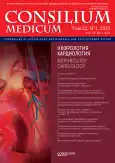Possibilities of combination lipid-lowering therapy in a patient with very high cardiovascular risk (dinical case)
- Authors: Sedykh D.Y.1, Fedorova N.V.1, Kashtalap V.V.1
-
Affiliations:
- Research Institute for Complex Issues of Cardiovascular Diseases
- Issue: Vol 23, No 1 (2021)
- Pages: 70-73
- Section: Articles
- URL: https://journals.rcsi.science/2075-1753/article/view/95426
- DOI: https://doi.org/10.26442/20751753.2021.1.200604
- ID: 95426
Cite item
Full Text
Abstract
Keywords
Full Text
##article.viewOnOriginalSite##About the authors
Daria Yu. Sedykh
Research Institute for Complex Issues of Cardiovascular Diseases
Email: md-sedih@mail.ru
канд. мед. наук, науч. сотр. лаб. Kemerovo, Russia
Natalia V. Fedorova
Research Institute for Complex Issues of Cardiovascular Diseasesканд. мед. наук, зав. консультативно-диагностическим отд-нием Kemerovo, Russia
Vasily V. Kashtalap
Research Institute for Complex Issues of Cardiovascular Diseasesд-р мед. наук, доц., зав. отд. клинической кардиологии Kemerovo, Russia
References
- Бойцов С.А. Профилактика неинфекционных заболеваний в стране: от «что делать» к «как делать». Профилактическая медицина. 2012; 2: 3-10
- Муромцева Г.А., Концевая А.В., Константинов В.В. Распространенность факторов риска неинфекционных заболеваний в российской популяции в 2012-2013 гг. Результаты исследования ЭССЕ-РФ. Кардиоваскулярная терапия и профилактика. 2014; 13 (6): 4-11
- Барбараш О.Л., Кашталап В.В. Роль фармакоинвазивной тактики ведения пациентов с острым коронарным синдромом с подъемом сегмента ST в России. Кардиология. 2014; 54 (9): 79-85
- Седых Д.Ю., Горбунова Е.В., Зыков М.В., и др. Факторы, связанные с риском смерти и госпитализации при развитии повторного инфаркта миокарда. Креативная кардиология. 2017; 11 (2): 98-108. doi: 10.24022/1997-3187-2017-11-2-98-108
- Барбараш О.Л., Каретникова В.Н., Кашталап В.В. Пациент после инфаркта миокарда: как снизить риск повторного ишемического события? Кардиосоматика. 2015; 6 (2): 12-9
- Reiner Z, De Backer G, Fras Z, et al. Lipid lowering drug therapy in patients with coronary heart disease from 24 European countries - Findings from the EUROASPIRE IV survey. Atherosclerosis 2016;246:243-50.
- Ibanez B, James S, Agewall S, et al. 2017 ESC Guidelines for the management of acute myocardial infarction in patients presenting with ST-segment elevation The Task Force for the management of acute myocardial infarction in patients presenting with ST-segment elevation of the European Society of Cardiology (ESC). Eur Heart J 2018; 39: 119-77. doi: 10.1093/eurheartj/ehx393
- Valgimigli M, Bueno H, Byrne RA, et al. 2017 ESC focused update on dual antiplatelet therapy in coronary artery disease developed in collaboration with EACTS The Task Force for dual antiplatelet therapy in coronary artery disease of the European Society of Cardiology (ESC) and of the European Association for Cardio-Thoracic Surgery (EACTS). Eur Heart J 2018; 39: 213-54. doi: 10.1093/eurheartj/ehx419
- Marenzi GS, Cosentino N, Campodonico J, et al. A new score for risk stratification of patients with acute myocardial infarction based on the PEGASUS-TIMI 54 criteria. JACC 2017; 69 (11): suppl. 14.
- Mach F, Baigent C, Catapano AL, et al. ESC Scientific Document Group. 2019 ESC/EAS Guidelines for the management of dyslipidaemias: lipid modification to reduce cardiovascular risk. Eur Heart J 2020; 41 (1): 111-88. doi: 10.1093/eurheartj/ehz455
- Stroes ES, Thompson PD, Corsini A, et al. European Atherosclerosis Society Consensus Panel. Statin-associated muscle symptoms: impact on statin therapy-European Atherosclerosis Society Consensus Panel Statement on Assessment, Aetiology and Management. Eur Heart J 2015; 36 (17): 1012-22.
- Ежов М.В., Сергиенко И.В., Кухарчук В.В., и др. Диагностика и коррекция нарушений липидного обмена с целью профилактики и лечения атеросклероза: Российские рекомендации, VI пересмотр. Атеросклероз и дислипидемии. 2017; 3: 5-22
- Сусеков А.В., Кобалава Ж.Д., Гуревич В.С., и др. Возможности клинического применения препарата эзетимиба Отрио («АКРИХИН», Россия) у пациентов высокого и очень высокого сердечно-сосудистого риска, не достигших целевых значений показателей липидного обмена. Заключение Совета экспертов. Кардиология. 2019; 59 (5S): 47-57
- Baigent C, Blackwell L, Emberson J, et al. Cholesterol Treatment Trialists’ (CTT) Collaboration. Efficacy and safety of more intensive lowering of LDL cholesterol: a meta-analysis of data from 170 000 participants in 26 randomised trials. Lancet 2010; 376: 1670-81.
- Ballantyne CM, Weiss R, Moccetti T, et al. Efficacy and safety of rosuvastatin 40 mg alone or in combination with ezetimibe in patients at high risk of cardiovascular disease (results from the EXPLORER study). Am J Cardiol 2007; 99 (5): 673-80.
- Ballantyne CM, Houri J, Notarbartolo A, et al. Ezetimibe Study Group Effect of ezetimibe coadministered with atorvastatin in 628 patients with primary hypercholesterolemia: a prospective, randomized, double-blind trial. Circulation 2003; 107 (19): 2409-15.
- Сусеков А.В. Двойное ингибирование холестерина: новые перспективы в лечении больных атеросклерозом. Атмосфера. Новости кардиологии. 2006; 1. Режим доступа: https://cyberle-ninka.ru/article/n/dvoynoe-ingibirovanie-holesterina-novye-perspektivy-v-lechenii-bolnyh-ateroskle-rozom
- Gagner C, Bays H, Weiss SR, et al. Efficacy and safety of ezetimibe added to ongoing statin therapy for treatment of patients with primary hypercholesterolaemia. Am J Cardiol 2002; 90 (10): 1084-91.
- Cannon CP, Blazing MA, Giugliano RP, et al.; IMPROVE-IT Investigators. Ezetimibe Added to Statin Therapy after Acute Coronary Syndromes. N Engl J Med 2015; 372 (25): 2387-97.
- Baigent C, Landray MJ, Reith C, et al. The effects of lowering LDL cholesterol with simvastatin plus ezetimibe in patients with chronic kidney disease (Study of Heart and Renal Protection): a randomised placebo-controlled trial. Lancet 2011; 377 (9784): 2181-92.
- Сусеков А.В., Зубарева М.Ю., Кухарчук В.В. Результаты наблюдательной программы по эзет-ролу «Исследование двух столиц». Фарматека. 2006; 8: 65-70
- Зубарева М.Ю., Рожкова Т.А., Соловьева Е.Ю., Сусеков А.В. Рандомизированное исследование ЭСКАДРА. Часть 1: гиполипидемическая эффективность, безопасность и переносимость эзетимиба, начальных доз оригинальных статинов и комбинации эзетимиба с начальными дозами статинов у больных ишемической болезнью сердца и гиперлипопротеидемией. Кардиоваскулярная терапия и профилактика. 2010; 9 (6): 1-9.45
Supplementary files






